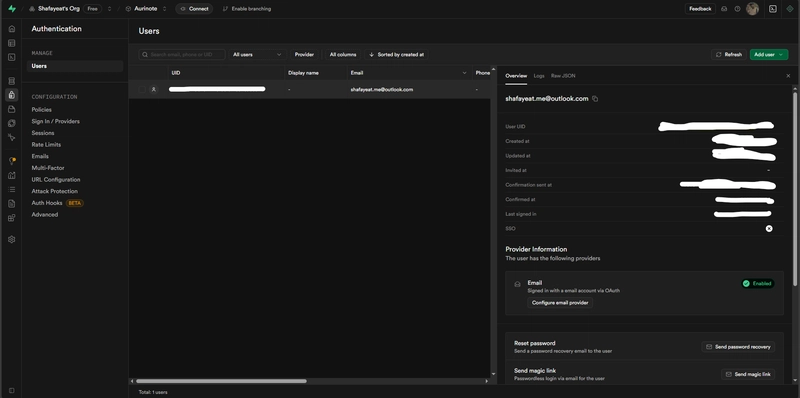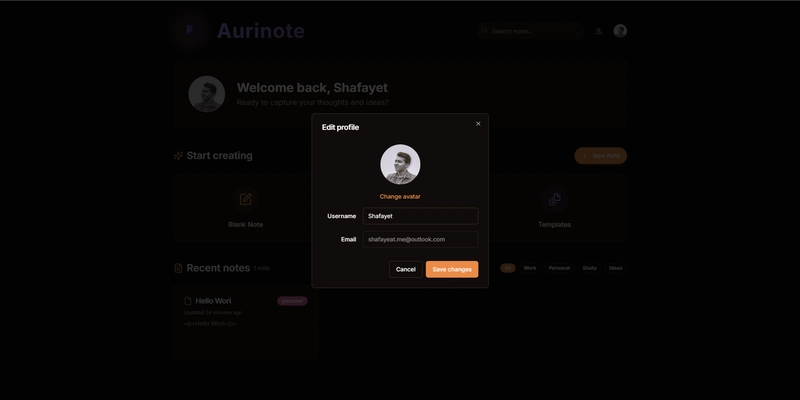Aurinote is a note-taking app built specifically with developers and modern productivity needs in mind. This post breaks down the tech stack, features, challenges, and development insights behind the project.
👇 Why I Built Aurinote
Honestly, i don't even know. I just wanted to build something like Notepad we usually get with the Windows by default and i end up with that.😭
🛠️ The Stack
Here’s a quick overview of the technologies used:
| Tech | Purpose |
|---|---|
| React + Vite | Frontend framework & fast dev server |
| TypeScript | Type safety and better DX |
| shadcn/ui + Tailwind CSS | UI and styling |
| Supabase | Auth, storage, and database backend |
| TipTap | Rich text editor |
| Highlight.js | Code block syntax highlighting |
| Tanstack Query | Data fetching and caching |
| Sonner | Toast notifications |
🔐 Supabase Auth + RLS
User accounts are powered by Supabase Auth with email + password. Each user has a profile including name and avatar, stored in Supabase storage.
(user_id = auth.uid())
This ensures that each user can only read, update, or delete rows where the user_id matches their authenticated ID. It’s a small line, but a huge step for securing user data. Supabase also handles session persistence, so users stay logged in across visits.
Rich Text Editing with TipTap
TipTap gives the editing experience a major boost, allowing:
- Headings, paragraphs, lists
- Code blocks with syntax highlighting
- Keyboard shortcuts for formatting
- Copy-paste support
All note data is stored in HTML format, giving flexibility in rendering.
Avatar Uploads + Compression
Users can upload a custom avatar, which is compressed client-side using a canvas API before uploading to Supabase Storage. This helps reduce storage size and improve loading performance.
Note Management
Notes are stored per-user and can be created, edited, and deleted from a dashboard view. The editor interface is simple and distraction-free, keeping the focus on writing.
Theming & UI
Built using Tailwind CSS and shadcn/ui, the interface is responsive, clean, and consistent across screen sizes. Features include:
- Dark/light/Vibe/Ocean/Sunrise/Forest mode
- Responsive design
App Structure Overview
While the codebase isn’t publicly available, here’s a quick look at how I structured the project internally for maintainability and scalability:
src/
components/
context/
pages/
services/
types/
hooks/
- Context handles global auth and theme state
- Hooks manage data fetching and session control
- Services handle Supabase API interactions
- Components include reusable UI building blocks
This modular structure helped keep the logic clean and organized, especially as features started to grow.
Challenges Faced
Authentication Refresh:
Keeping the app in sync after login/logout or profile updates was trickier than expected. Supabase session changes didn’t always propagate cleanly across components, so I implemented a global context and used a useEffect listener on onAuthStateChange to keep everything reactive.
Image Upload Optimization:
Raw uploads were slow and bulky. To reduce file sizes and improve UX, I compress images client-side using the HTML canvas API before sending them to Supabase Storage.
UI Sync & Cache Invalidation:
Some UI elements weren’t updating instantly after changes especially on note edits or theme toggles. I introduced conditional re-fetching and manual state updates in context to patch these sync delays.
Row-Level Security (RLS) Headaches:
Supabase's RLS is powerful, but even one wrong policy can block data or expose too much. Debugging policy logic while working with multiple users and shared notes was a bit of a minefield. Had to write precise rules and test thoroughly to avoid privilege leakage.
Supabase Rate Limits & Quotas:
When syncing notes across multiple sessions or devices rapidly (e.g., for real-time collab), I ran into some subtle Supabase request throttling. Caching responses locally and debouncing input saves helped reduce strain.
Responsive Design with State-Heavy UI:
Because of animations, theme toggles, and real-time syncing, managing layout shifts without UI jank (especially on mobile) was a major design+tech balancing act. I used Tailwind with media queries and conditional rendering to minimize unnecessary re-renders.
Features Completed
- User registration & login
- Profile management (avatar + name)
- Create/edit/delete notes
- Rich text editing
- Syntax-highlighted code blocks
- Responsive layout
- Light/dark theme toggle
- Keyboard shortcuts
Next Steps
Aurinote is still under development, but upcoming features might include:
- Real-time collaborative editing
- Offline mode
- Exporting notes (PDF, Markdown)
- Tagging and search functionality
- Mobile-friendly PWA
Whatever,,,
Aurinote started as a side project, but it’s grown into something genuinely useful for everyday writing and note taking. If you’re a developer who wants a focused space to think, plan, or write—this might be a good fit🤷♂️
CHECK IT OUT
Github
Feel free to share feedback or ideas in the comments!!!












Top comments (0)